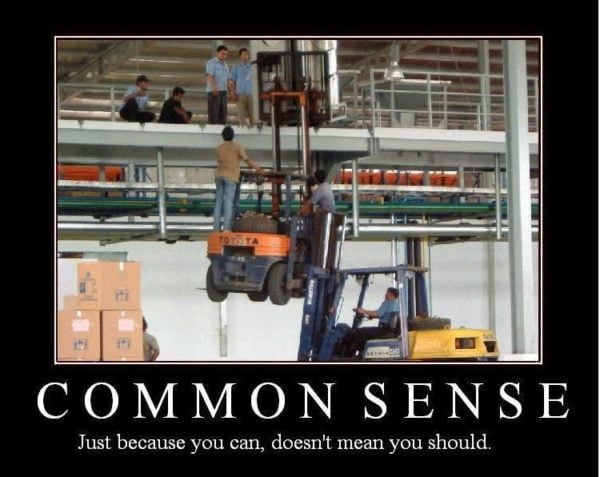While there’s nothing in the Approved Code of Practice that says you cannot use two forklifts to lift a load, it is not advisable as a lot can go wrong. The scenario is quite common: a load arrives on a truck and it’s a few hundred kilos heavier than the rated capacity of one forklift
What the ACOP does say is that a cause of forklift accidents is exceeding the rated capacity of the forklift, which would happen if one of the two forklifts were to fail.
In theory, two forklifts should be able to lift much more than one forklift, but that is not the case because the drivers have to contend with:
- Raising and lowering the load at the same time and same rate without the load becoming unbalanced
- Picking appropriate points to lift the load from so that the load remains balanced
- Getting the second forklift close enough to the load so that the load is effectively and safely on the tines or forks.
These problems are made much worse if the two forklifts being used are of different sizes and rated capacities.

What can go wrong if two forklifts lift a load?
- One forklift lowers or raises a load too quickly and it transfers weight in a way that overloads one of the forklifts, which then tips or is damaged
- One forklift lowers or raises a load too quickly and the load becomes unbalanced and falls off the forks
- The load is not designed to be lifted from multiple points (e.g. it has specific slots for one forklift to lift it)
- One forklift can’t get close enough to the load, therefore the load sits too far from the backrest and either bends the forks, stresses the mast or slips off. Also bear in mind that the further the load from the backrest, the less the forklift can lift.
Can you ever lift a load with two forklifts?
There are scenarios where two forklifts could be required, and there are methods which reduce the risk of an accident, for example, a really long load which requires two wide support points to stop it bending down at either end (e.g. long timber or steel loads being loaded onto a truck. In this case, both the forklifts should have a rated capacity exceeding the weight of the load. A control person should be used to instruct the drivers who will work in sync.
Another example is a large piece of machinery lifted either side by a forklift using a gib lifter attachment from designated lifting points either side. The machinery can be raised and a flat-deck truck backed underneath it. This technique saves getting a crane in to do it. One forklift on its own would need much more capacity than the two forklifts because the single lifting point would have to be in the middle of the trailer (i.e. at least 1.3m from the backrest, whereas a forklift either side could have the lifting points much closer to their backrests.

